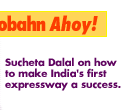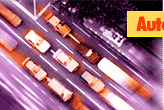|
|
|
|
|
| HOME | BUSINESS | COLUMN | |||
|
May 15, 2000
BUDGET 2000 |
The Rediff Business Column/Sucheta Dalal 
Taking a commuter taxi back from Pune to Bombay last week, we asked the driver to use part of the Bombay-Pune Expressway that has been opened up to the public (approximately a third of the 86 kms). The man first turned grim and sullen; after a while he said we would have to cough up the Rs 25 toll charge. The fact that we readily agreed did not please him either. When we stopped for a tea break at Lonavala, the cabbie went into a huddle with a colleague and brought him over to advise us against using the Expressway.
Together, they trotted out the most incredible rubbish about the road being lonely, about not finding help if there was a problem, about how it may be dangerous after dark and so on. We were also told that the big wide road was bad for battered old Ambassador taxis and only meant for new cars. Amazed, we pointed out that it was bright daylight and a long time before dusk and that the new road would in fact cut the distance to Bombay. The toll issue came up again, and after yet another assurance, the cabbie reluctantly agreed to take the Expressway. Curiously, when we repeated that we would pay the toll, the second taxi driver quickly changed his tune. "If you are paying the toll then take the 'naya (new) road'," he said, "it is beautiful, like a mirror" (sheeshe jaisa). It was a revelation. The ignorance level in India is so high that even a good thing can be killed by false fears, rumuors, superstition or worse because people, like our cab driver do not even want to try out a new thing. The Bombay-Pune Expressway, a spanking, modern, six-lane highway will, when completed, be India's first truly international road constructed on the lines of the autobahn or the turnpike. Fully fenced on either side, it will actually prevent the usual spillover of cattle, children, bullock carts and people on to the carriage-way by providing villages on either side with some form of crossing every 500 metres in a combination of underpasses (26), overpasses (20), cart and pedestrian crossing (31), two rail over-bridges and 81 culverts. It has five tunnels including one at Bhatan (1658 metres), which is the longest in Asia and the most modern in the country. Who pays the toll is a minor issue today when only a third of the Expressway is open to the public. But it is evident that the Maharashtra State Road Development Corporation (MSRDC) cannot rest after completing construction. It will have to educate people about exact cost reduction due to fuel saving, the speed advantage, ease of driving and the reduction in wear-and-tear of the vehicles. It will have to work through the taxi drivers unions to educated drivers and maybe even dish out a few free passes to encourage them to use the road. MSRDC will also have to watch out for other hidden hazards such as the Indian antipathy for rules and discipline. Though a fence barricades the Expressway, curious villagers simply jump the fence to gawk at speeding traffic. The high speed of traffic (120 kms per hour or more) will increase the need for traffic discipline and patrolling particularly in case of truck drivers. A large number of accidents and deaths occurring on the national highways today are the result of overloaded trucks, ill-maintained vehicles and drunken driving. MSRDC officials are aware of the hazards and have plans to deal with them. Breath analyzer tests, weight checks for trucks and containers and rigorous patrolling by a specially created and trained traffic police corps are part of their planned arsenal to ensure road safety. Yet, one gets the impression that senior officials are, quite rightly, focused on completion of the project, and would like to worry about other details only when it is completed. If the MSRDC is not immediately vigilant, it may learn to its cost that managing public opinion is as important as the construction of a magnificent project in record time. India is a little different from the developed world because discipline of any kind is alien to us. Along with the right to spit in public, we will resist all attempts to discipline our driving. As pedestrians, we will cross any road at will, and as cops, we will view traffic offences as business opportunities. A year ago, residents of Thane had objected to a smooth new road, because it allowed cars to attain high speeds and had increased the number of accidents. The people demanded the installation of the simple and ubiquitous speed-breakers rather than a subway. It is the same on the Western Express Highway. Though the highway has been around for decades, the government has never thought it fit to construct pedestrian subways. Instead, speeding traffic is always halted for pedestrian crossing and ever so often a driver who fails to stop in time kills people and sometimes gets beaten to death himself. Where pedestrian subways do exist - at the crowded Churchgate and Victoria Terminus Stations (now Chattrapati Shivaji Terminus) they are choked by hawkers and are often unsafe. So much so that people react with anger at the mere suggestion that car owners will have right of way while they are herded into a subway. Since hawkers occupy pavements, pedestrians usually take over the last road lane and justify indiscriminate crossing. The net result is a no-win situation. The only solution is for the government to be more responsive, to talk to citizens groups and force discipline on every segment of society. Today, each segment is represented by articulate interest groups talking at each other, unwilling to compromise and the government is corrupt, inefficient, and indifferent. A complete solution, equitable to every segment seems a pipe dream; the only alternative is to work on what is doable. The construction of 30 odd flyovers is a solution in this category. Hopefully the obvious de-congestion will create a demand for better infrastructure and sensible solutions.
From The Rediff Archives: Six-lane expressway to shrink Bombay-Pune travel time to 150 mins Expressway tipped to help hotel industry MSRTC to develop 'mega cities' to support expressway Expressways are essential, a priority, PM tells industry
|
| Tell us what you think of this column | |
|
HOME |
NEWS |
BUSINESS |
MONEY |
SPORTS |
MOVIES |
CHAT |
INFOTECH |
TRAVEL SINGLES | NEWSLINKS | BOOK SHOP | MUSIC SHOP | GIFT SHOP | HOTEL BOOKINGS AIR/RAIL | WEATHER | MILLENNIUM | BROADBAND | E-CARDS | EDUCATION HOMEPAGES | FREE EMAIL | CONTESTS | FEEDBACK |
|